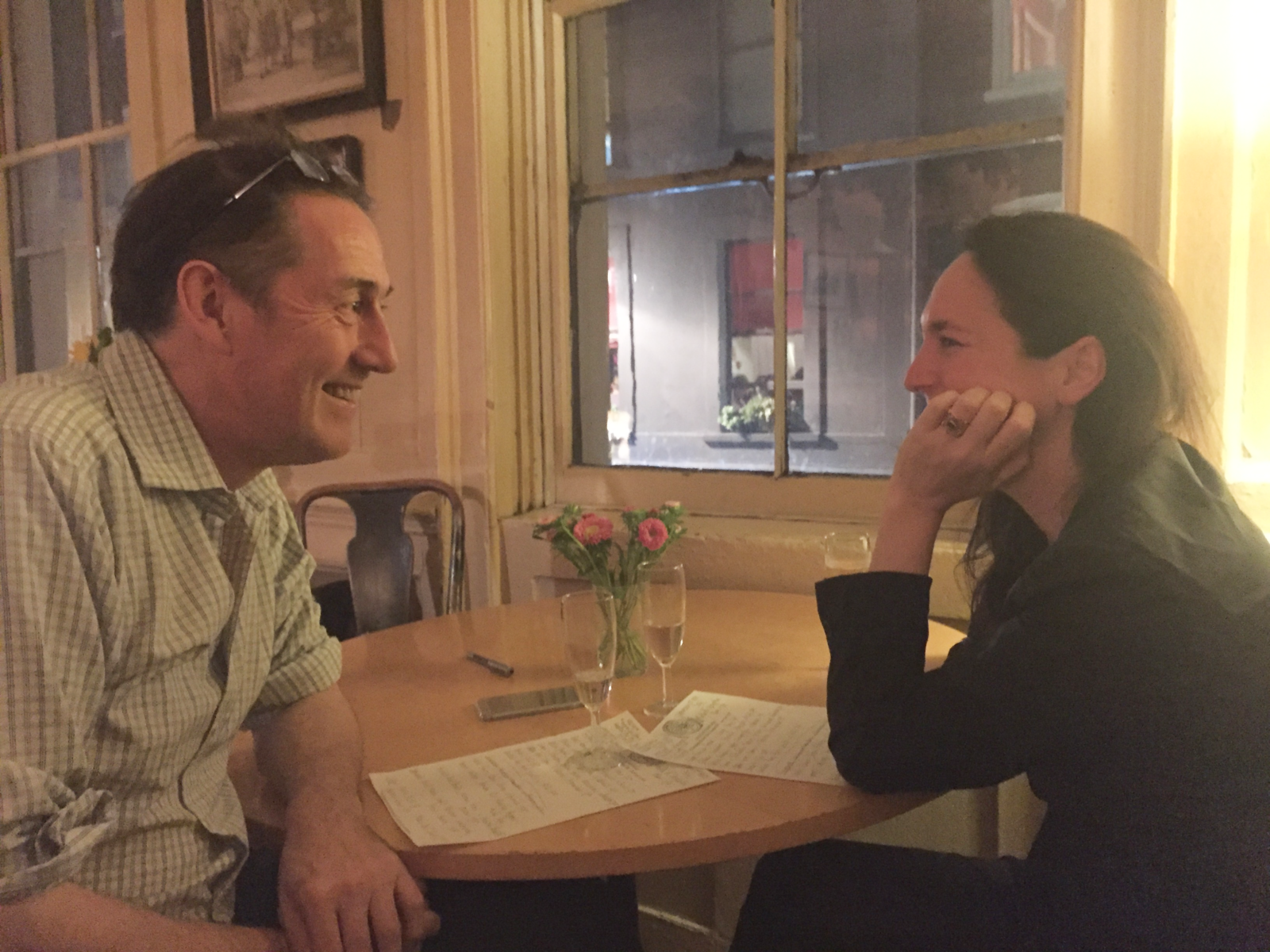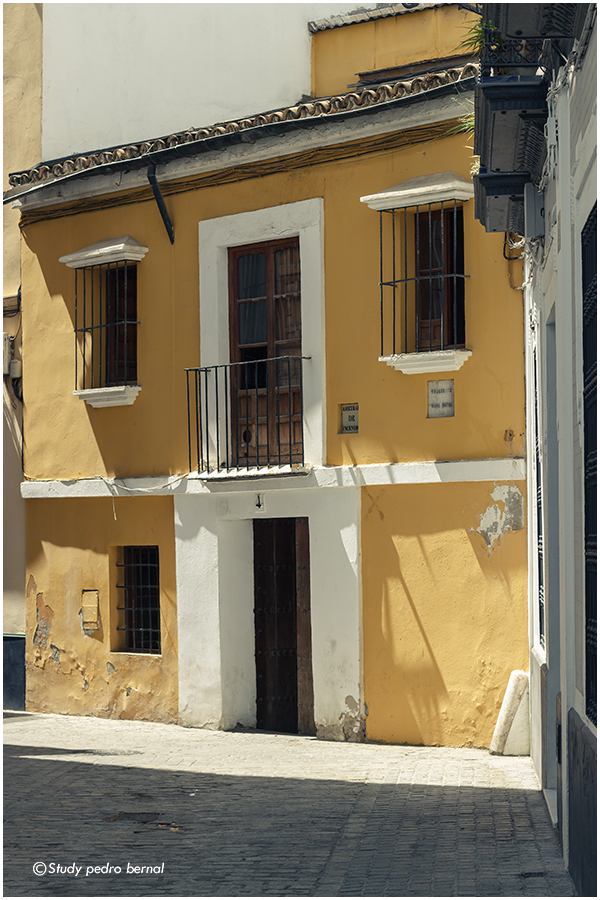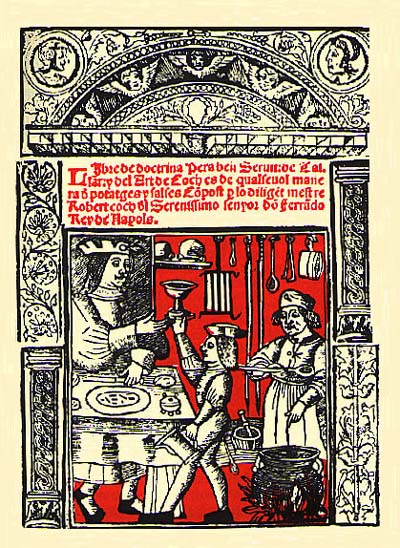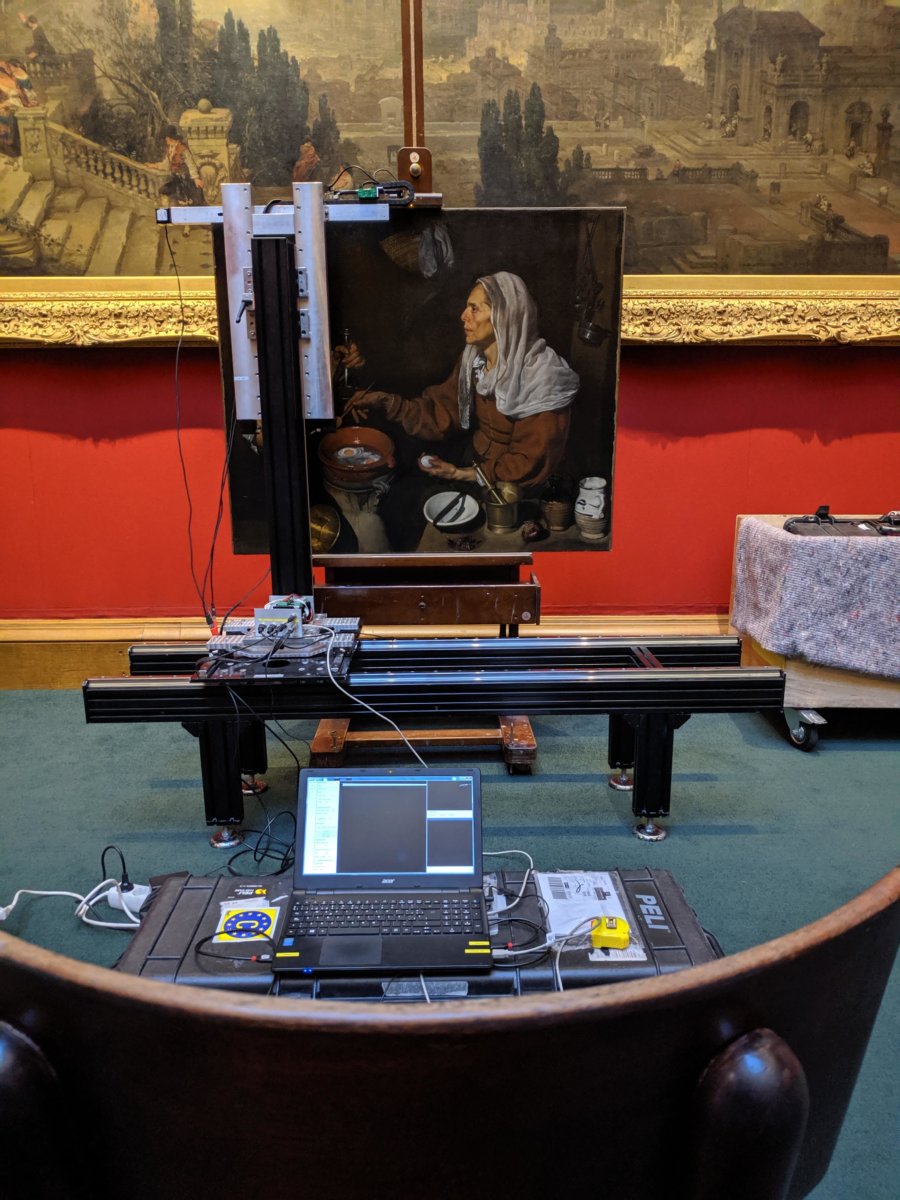British architect Charlotte Skene Catling and her partner, artist Adam Lowe, know something about structure and space. They also know about representation and taste. Their the latest project about the painter Diego Velázquez's is the starting point to an intriguing conversation (and recipes) with this unparalleled and adventurous couple.
Food, art and recipes: 16th century musings with Adam Lowe and Charlotte Skene Catling
British architect Charlotte Skene Catling and her partner, artist Adam Lowe, know something about structure and space. They also know about representation and taste. She is the co-founder of the architectural firm Skene Catling de la Peña, while he re-imagines and materializes physical sites using digital technology with Factum Arte and Factum Foundation for Digital Technology in Conservation, the Madrid-based, multi-disciplinary workshop he founded in 2001. The company aims to conserve cultural heritage by constructing a bridge between new technologies and craft skills in conservation. Using various forms of high-definition 3D scanners they have been able to record, in digital form using non-contact equipment, a number of endangered sites and objects of cultural importance.

Charlotte and Adam have often collaborated on texts pertaining to their work, musing on the effigy of King Idrimi from Syria, Walter Benjamin’s essays on reproduction, and the sound of silence in the Valley of the Kings. They often play around with preconceived notions of ‘originality’ and ‘authenticity’, asking how preservation can be accomplished in a way that reflects changing time. The couple married in Venice, on the island where Factum Arte’s facsimile of Paolo Veronese’s masterpiece, The Wedding at Cana (1563), resides. Their latest project is the artistic restoration of the C16th modest house where the Spanish painter Diego Velázquez was born, which was recently bought by a writer and a small collective conservationists. For the renovation and reinvention of this house in Seville, naturally they asked the Factum Foundation to produce all the work for the new Museum, which will focus on the early work of Velázquez. In his early career in Seville, Velázquez painted a number of kitchen scenes, known as ‘bodegones’ a particularly Spanish genre of still life painting. This depiction of food in art is the starting point to an intriguing conversation (and recipes) I had the privilege of sharing with this unparalleled and adventurous couple.
Here you can listen to the entire conversation.
And here are some of my favourite extracts.
Aiste: Over lockdown many of us have spent a lot of time cooking at home. Instead you started researching the food in Diego Velázquez’s work… how he portrayed it…
Adam: Casa Natal de Velázquez is going to be a new type of museum. We aim to recreate the environment that allows you to understand what it was like to live in Seville in the first 25 years of the 1600s. The starting point was looking at the painting, “The Old Woman Cooking Eggs”, and starting to think about what it was like to live there at that time. Velázquez was born in 1599, which was a plague year. His grandparents died in a plague, it was the first of the black plagues to devastate the city. But Seville was probably the richest city in the world, it was the gateway to the new world, to the Americas. They were flooding Europe with new things, from tobacco to maize and cotton, to a lot of new ingredients from potatoes to tomatoes to chilli peppers… But looking at this painting, and “The Old Woman Cooking Eggs” on top of a simple fire, with a sort of chimney, under a ceramic bowl, leads to thinking that basically this is pretty similar to the cooking equipment of people in the new world. To the Aztecs and Incas and the people who were living in Mexico and down south, or the pre-Columbian indigenous communities of the north for basically cooking in ceramic vessels over open fires and sometimes controlling the heat. Velázquez is an extraordinary painter of materials, so you look at the clay, at the ceramic of the simple vessels, and the ceramic bowl, and the charcoal, which is in the stove where the old lady is cooking, you look at the clothes they are wearing and the texture of the fabric. And then Charlotte and I started thinking about what they were eating…

Charlotte: There was a recipe book, published in 1520 in Barcelona by Ruperto de Nola, called Libre del Coch (the Book of Cooking). It’s a fascinating reflection of how strong the Arabian influence was in Spain at that time, it’s filled with these very strange recipes, a lot of them using cinnamon, cloves, rose water, pomegranates, quite a lot of sugar.

Adam: The book was published in 1520. In 1492 Columbus crossed and discovered a new world. He was trying to discover the East, he was trying to find a shortcut to the Moluccas. He was trying to get to the spices, because at that time Venice controlled the spice trade from the east. So exactly as Charlotte said, a lot of cooking in Spain was very influenced by the Arab culture that had been there for more than 700 years until 1492 when Granada fell. Then was the first expulsion of the Jews and the Muslims. And really one of the things which shocked me a lot when we started talking about Velázquez…
It’s worth remembering that Velázquez almost certainly was a ‘converso’ [a Jewish person who converted to Catholicism in Spain or Portugal, particularly during the 14th and 15th centuries]. His grandparents came in at the end of the 16th century from the south of Portugal with the name ‘de Silva’, which is almost certainly a Jewish family who were coming to live in Sevilla. Velázquez was baptised (to live there you had to be a Christian, the Inquisition was very, very strong at that time) in 1608, when he was nine years old. Then was the expulsion of all of the Conversos, of all the Jewish community and the Islamic community, who had converted to Christianity.

Now we are in the era of rising political correctness and control, but then it was pretty absolute, and extreme decisions were made. Imagine expelling people who have been there for 700 years and then converted?! So, what Charlotte wanted us to notice was this mix of Jewish, Arabic and Christian traditions all colliding throughout the 16th century. And then in the 17th century, all these new ingredients arrived!
Charlotte: The titles of the recipes from the book I mentioned sort of draw a picture in the same way as Velázquez’s paintings do, to intrigue you and give you such an insight to human beings. It’s a real connection through food, which I know that you’ve discovered through your website and travels around the world.
To give you a few titles: here is one – ‘Electuary (a sort of sauce) of sour cherries for sick people who have lost the desire to eat’, or another one – ‘To eat figs in the French manner’, and this is a rather delicious thing to do with figs …
“To eat figs in the French manner”
“Take dried figs, the sweetest that you can get, black and white, and remove the stems and wash them with good white wine which is sweet; and when they are very well-cleaned, take an earthenware casserole which is big enough, which has a flat bottom, and cast them inside, stirring them a little; and then put this casserole upon the coals, and well-covered in a manner that it is stewed there. And when they are stewed, and they will have absorbed all of the moisture of the wine, stir them a little, and cast fine spice on top of them; and turn them, stirring in a manner that incorporates that spice in them; and then eat this food; And it is an elegant thing; and it should be eaten at the beginning of the meal.
You have this whole thing, and the spices they described for it are different parts of the book.
Here is another recipe.
“A thin sauce from a juice of sour pomegranates”
“Take a cup of the seeds of sour pomegranates and thoroughly extract the juice from them; and then take a roasted hen’s liver, and grind it well in a mortar with eight egg yolks; and when it is all well-ground, strain it through a woolen cloth; and when it has been strained, put it in the pot or an earthenware casserole. And take an ounce of cinnamon, or cast in the spice according to the quantity which you desire to make, and let it be ground and blended with the said juice; and cast four ounces of sugar on it, and then set it on a fire of coals and cook it until it begins to thicken; and this sauce is good for all fowls in place of sauce for peacock; and it is made very quickly.”
Aiste: Did you try to make any of these recipes?
Charlotte: Some of these, yes. We were using a lot of almonds, we were cooking in terracotta pots, roasting quite a lot of birds, quail.
Adam: … also a lot of things with chia seeds and quinoa; both these ingredients came from the new world, South America. A list of ingredients from there includes…obviously cotton and tobacco which fundamentally changed the world in the 16th and 17th centuries and also… avocados. One of my favourite discoveries is that the name avocados comes from the indigenous word for ‘testicles’. When you look at avocados, it’s quite easy to understand.
The titles of the recipes from the book sort of draw a picture in the same way as Velázquez’s paintings do, to intrigue you and give you such an insight to human beings.
Charlotte Skene Catling
Charlotte: The roast peppers with anchovies were rather good. They used quite a lot of preserved fish as a way of flavouring, you know, you have these ‘umami’ tastes as they develop. Garlic and fennel combined with oil as a way to flavour meats was another one.
Adam: I love the way Charlotte was cooking garlic by just putting the bulb into earthenware bowls, cutting a whole head of garlic in half. And it sort of becomes this weird sweetness and spiciness together. It was almost my favourite, cooked with pork, oil and wrapped in bacon. and at that time, one way you proved people were true Conversos was by making them eat pork.
Charlotte: And still now in Spain, many sweet biscuits and pastries are made with lard, cause that was originally a really sneaky way of trying to reveal who people really were. They seem quite diabolical, these tricks, but they are still locked into the food culture of the country.
At that time, one way you proved people were true Conversos was by making them eat pork.
Adam Lowe
Aiste: It’s fascinating how the food is political, what we can eat and what we can’t.
Charlotte: Exactly, political, cultural, ceremonial… so many different layers to it, it’s so embedded in culture and human beings, you have to eat to survive, but it’s been taken to such an extreme, beyond what is necessary for survival.
Adam: “Is cooking an art form?” For me, when I was looking again at these paintings, thinking about food: why did Velázquez continually paint domestic scenes? I see he painted the ‘Old Woman Cooking Eggs’. Why is he painting ‘The Waterseller in Seville’ which we recorded two weeks ago? Which is an extraordinary painting. It’s worth asking not why he was painting, but how? How did a 17 to 18-year-old boy have the ability in Seville to paint things which are so sophisticated, and have such a deep understanding of the texture and surface and quality of light?
Charlotte: One thing about Velázquez paintings that’s so fascinating is that they give a sense of temporality – of time – you all know how long it takes to fry an egg. So, when you look at the painting, you occupy a very immediate moment of time. You immediately know how long it takes, the sound, the smell, you know everything. You feel it.
Aiste: Many people say that art has to have lasting value, that’s why food is not art. Because that moment of time, those smells, that sound, that moment finishes at a certain point, it’s not art anymore. But Velázquez has frozen that time, he captured that time and it is very fascinating. Why do you think that 17 to 18-year-old boy decided to portray food?
One thing about Velázquez paintings that’s so fascinating is that they give a sense of temporality – of time – you all know how long it takes to fry an egg. So, when you look at the painting, you occupy a very immediate moment of time. You immediately know how long it takes, the sound, the smell, you know everything. You feel it.
Charlotte Skene Catling
Adam: To come back to the pictures of ‘The Waterseller of Seville’, that sophistication of what they were doing and the water seller, it’s almost like a demonstration of what he [Velazquez] can do. He can paint clay, we can see that from some of his other paintings, he can paint cloth and clothes, he can paint the copper pan, he can paint garlic and a red onion specifically, because he is looking. But in ‘The Waterseller’, he also paints the glass, the stacked glass. Inside the glass, there is a fig, and one of the things that Charlotte was experimenting with a lot was putting things into water to change their flavour, so obviously lemon, but also orange peel. And putting orange peel into coffee. And playing with the point when flavours are slightly unexpected.
Charlotte:

“Electuary of sour cherries for sick people who have lost the desire to eat”
“Take as many sour cherries as you wish and put them in a saucepan upon the fire; and cast them in water by themselves, and let them cook in that water until they turn very tender and appear white; and then throw out that water of theirs in which they cooked; and then take a sieve of very thin horsehair, in which you can strain them, and rub them so much with your hands that everything passes through. Then for each pound of these cherries prepared like this, take half a pound of sugar and mix it in your saucepan on a gentle fire, constantly stirring with a cane until they are cooked; and then put it aside; and put this electuary in a vessel of glazed earthenware, well-stoppered; if you wish, you can put some cloves and a little cinnamon in it.”
I loved the way you get a sense of the hands, and actions, like stages of a painting, like listening to Velázquez painting.
If you think of other paintings of that period, still lives of fruits or flowers, this was such an important subject: memento moris. The temporality of cooking and eating represented time passing, our lives passing… things that could only last for a short period of time. That is so fundamental… It makes cooking and eating one of the greatest of arts, the most fundamental.
If you think of other paintings of that period, still lives of fruits or flowers, this was such an important subject: memento moris. The temporality of cooking and eating represented time passing, our lives passing… things that could only last for a short period of time. That is so fundamental… It makes cooking and eating one of the greatest of arts, the most fundamental.
Charlotte Skene Catling
Adam: The transformation of oil paint into other materials is just like cooking where tastes and ingredients are transformed into extraordinary composite mixes of subtle flavours. I think it wasn’t just one-way traffic from the new world, it was two-way. So, we sent them things as well. Probably not all desirable ones, I’m sure lots of people in the Caribbean would much rather sugarcane hadn’t been introduced to the new world. What else did we take? Sugarcane, wines (not wine initially because it took time to make wine in the new world) but grapes, coffee, citric fruits and olives. In the new world, olives were one of the greatest luxuries, but obviously, later the olive oil, melons and mangos which were going from the east to the west, from India.
Charlotte: I have got another recipe here. A lot of ones I have already read or refer to show how close we are to people in the 1520s in terms of what we eat and how we think about food, what impact food might have on us as human beings. This one maybe sets us apart from that period. This is,
“Roast cat as you wish to eat it”
“You will take a cat that is fat and decapitate it. And after it is dead, cut off the head and throw it away because it is not for eating, for they say that eating the brains will cause him who eats them to lose his senses and judgment. Then flay it very cleanly, and open it and clean it well, and then wrap it in a cloth of clean linen. And bury it beneath the ground where it must be for a day and a night; and then take it out of there and set it to roast on a spit. And roast it over the fire. And when beginning to roast it, grease it with good garlic and oil. And when you finish greasing it, whip it well with a green twig, and this must be done before it is well-roasted, greasing it and whipping it. And when it is roasted, cut it as if it were a rabbit or a kid and put it on a big plate; and take garlic and oil blended with good broth in such a manner that it is well-thinned. And cast it over the cat. And you may eat it because it is very good food.”
Aiste: What is interesting is that Velázquez was born during the plague and we are also living something similar at the moment. We always come back to the subject of food somehow.
Charlotte: Exactly, ‘food as medicine’ is a huge subject itself, what and how you eat and how it affects you, how you feel, function and survive.
Aiste: Do you think a perfect dish can bring the same emotion as a masterpiece, painting?
‘Food as medicine’ is a huge subject itself, what and how you eat and how it affects you, how you feel, function and survive.
Charlotte Skene Catling
Charlotte: I think so.
Adam: I think that with the right company, eating a perfect dish can really focus you in amazing ways. You are involved and engaged differently when talking and sharing food. Like paintings – they also need to be shared, you need to discuss them, look at them, and somehow engage with them in good company. So, in that sense they are very similar.
I think that with the right company, eating a perfect dish can really focus you in amazing ways. You are involved and engaged differently when talking and sharing food. Like paintings – they also need to be shared, you need to discuss them, look at them, and somehow engage with them in good company.
Adam Lowe
Charlotte: I think that one of the most powerful things about a great work of art is how you enter into the thinking of the person who is creating it: whether a good painting or a great book, or a beautiful piece of music. It gives you the ability to see the world through someone else’s eye, and I think that also happens with food. I think when you are eating something that’s been conceived of with vision, you really do experience that sense of being transported: that you can perceive something as it was conceived by someone else. And I think that’s great art.
What we are trying to do is to make a kitchen as it would have been in the 16th century and which could still be functioning as a kitchen used for the people visiting. That would connect to the period more instantly and directly than anything else, to be able to eat as they ate. You are instantly in a different mind-set; you are instantly transported.

The scanner is a close-range, non-contact laser recording system that captures high-resolution surface texture data for low-relief surfaces such as paintings or bas-reliefs. The Lucida hardware and software were conceived and developed by artist and engineer Manuel Franquelo together with a team of artists, conservators and engineers at Factum Arte.
Credit line: Gabriel Scarpa for Factum Foundation
Aiste: When you look at history, it’s written by the ruling, and we imagine there were feasts and all this extravaganza, we don’t know much about what simple people were doing. That really fascinates me, what simple people were cooking and eating.
Charlotte: Yes, there is a recipe for an “Armored Capon” (little birds).
“Armored Capon”
“Bard a capon and roast it; and when it is half-roasted remove the barding fat. And take egg yolks beaten with parsley and sugar, and let them be very well-beaten, and put these eggs all over the capon; and take pine nuts and peeled almonds, and while you put on the egg yolks, put on the pine nuts and almonds bit by bit in such a way that they will adhere to the sauce. And then put the barding fat back on over the eggs and the capon. And it shall be upon the fire until it is completely roasted.”
I think that one of the most powerful things about a great work of art is how you enter into the thinking of the person who is creating it: whether a good painting or a great book, or a beautiful piece of music. It gives you the ability to see the world through someone else’s eye, and I think that also happens with food.
Charlotte Skene Catling
Adam: At the beginning of the 17th century it was amazingly complex, the flavours were extraordinarily mixed of the old world and the new world, and all the Abrahamic religions rolled into the same cooking pot. And it produced an extraordinary moment in time. Velázquez paintings somehow capture this, the act of cooking, the act of cleaning, the act of what utensils they are using, and what tools they are using.
To listen to all of this insightful and rich conversation, go here.
Thanks to Adam and Charlotte for providing us all with this food for thought from the past and into the future.
